The cost of Mastectomy in Thailand ranges from THB 432791 to 499100 (USD 12140 to USD 14000)
Mastectomy in Thailand is done for treating breast cancer. This treatment is required when the woman can not be treated with lumpectomy, that is to say, it will not be of many benefits to the patient. In this, the cancerous tissue is removed from one or both breasts. Mastectomy can also be performed for treating Paget’s disease or gynecomastia.
And people also get it done for personal reasons as well. Also, mastectomy is of different types depending upon the cause of the surgery and the extent of tissue that needs to be removed. It can be a double mastectomy, skin-sparring mastectomy, nipple-sparring mastectomy, etc.
The surgery can take from 1 to 3 hours and on completion, you will need to stay in the hospital for a day or two. The stay can be longer depending upon the medical condition of the patient. Also, it will take you a few weeks to fully recover and return back to daily activities completely. For around a period of 15 days, you might need to stay in the country for further checkups and treatment required, if any.
Also, the success rates of the treatment are high and patients were able to live up to 10 years after the surgery.
The lowest price for Matectomy cost in Thailand can be $3500.16 and as high as $7343.15. So based on your requirement and a number of other factors you can get the treatment from a suitable clinic or hospital.
| City | Minimum Cost | Maximum Cost |
|---|---|---|
| Krabi | USD 12230 | USD 13040 |
| Bangkok | USD 12140 | USD 13840 |
| Country | Cost | Local_currency |
|---|---|---|
| Greece | USD 12000 | Greece 11040 |
| India | USD 3000 | India 249450 |
| Israel | USD 8500 | Israel 32300 |
| Lebanon | USD 9500 | Lebanon 142552725 |
| Malaysia | USD 8000 | Malaysia 37680 |
| Poland | USD 3050 | Poland 12322 |
| South Korea | USD 20000 | South Korea 26853800 |
| Spain | USD 10220 | Spain 9402 |
| Switzerland | USD 9500 | Switzerland 8170 |
| Thailand | USD 12140 | Thailand 432791 |
| Tunisia | USD 9500 | Tunisia 29545 |
| Turkey | USD 6080 | Turkey 183251 |
| United Arab Emirates | USD 12120 | United Arab Emirates 44480 |
Treatment cost
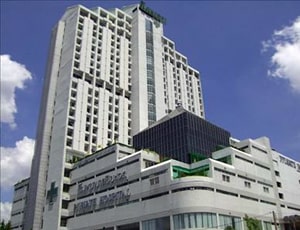
Types of Mastectomy in Piyavate Hospital and its associated cost
| Treatment Option | Approximate Cost Range (USD) | Approximate Cost Range (THB) |
|---|---|---|
| Mastectomy (Overall) | 6638 - 17106 | 243939 - 588495 |
| Total Mastectomy | 6715 - 9043 | 239994 - 325323 |
| Modified Radical Mastectomy | 7944 - 10263 | 286303 - 367681 |
| Radical Mastectomy | 9184 - 11100 | 314140 - 395489 |
| Double Mastectomy | 9983 - 12394 | 359161 - 435449 |
| Skin-Sparing Mastectomy | 7740 - 10281 | 278268 - 355034 |
| Nipple-Sparing Mastectomy | 9163 - 11157 | 316856 - 403298 |
| Subcutaneous Mastectomy | 6797 - 7769 | 235844 - 283957 |
| Prophylactic Mastectomy | 8830 - 12558 | 326688 - 431390 |
SPECIALITIES
FACILITIES & AMENITIES
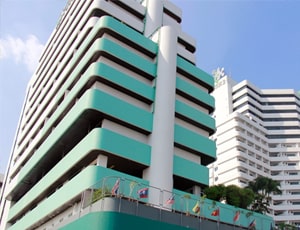
Types of Mastectomy in Phyathai 2 International Hospital and its associated cost
| Treatment Option | Approximate Cost Range (USD) | Approximate Cost Range (THB) |
|---|---|---|
| Mastectomy (Overall) | 6607 - 17009 | 242996 - 601511 |
| Total Mastectomy | 6836 - 9019 | 238392 - 316617 |
| Modified Radical Mastectomy | 7979 - 10177 | 282981 - 363057 |
| Radical Mastectomy | 9192 - 11170 | 324651 - 404197 |
| Double Mastectomy | 10246 - 12315 | 366759 - 443448 |
| Skin-Sparing Mastectomy | 7788 - 9954 | 285650 - 364986 |
| Nipple-Sparing Mastectomy | 8847 - 11235 | 316703 - 399634 |
| Subcutaneous Mastectomy | 6758 - 7890 | 238562 - 280661 |
| Prophylactic Mastectomy | 8849 - 12356 | 327803 - 434960 |
DOCTORS IN 11 SPECIALITIES
FACILITIES & AMENITIES
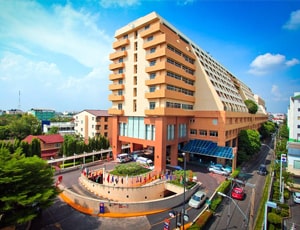
Types of Mastectomy in Vejthani Hospital and its associated cost
| Treatment Option | Approximate Cost Range (USD) | Approximate Cost Range (THB) |
|---|---|---|
| Mastectomy (Overall) | 6647 - 16639 | 235421 - 589710 |
| Total Mastectomy | 6735 - 9069 | 239645 - 316253 |
| Modified Radical Mastectomy | 8043 - 10200 | 278417 - 365511 |
| Radical Mastectomy | 8832 - 11485 | 327352 - 403798 |
| Double Mastectomy | 10335 - 12129 | 359385 - 431763 |
| Skin-Sparing Mastectomy | 7785 - 10307 | 282527 - 361025 |
| Nipple-Sparing Mastectomy | 8996 - 11304 | 327792 - 403958 |
| Subcutaneous Mastectomy | 6645 - 7748 | 243477 - 275312 |
| Prophylactic Mastectomy | 9101 - 12347 | 325232 - 448135 |
DOCTORS IN 13 SPECIALITIES
FACILITIES & AMENITIES

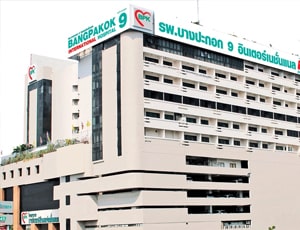
Types of Mastectomy in Bangpakok 9 International Hospital and its associated cost
| Treatment Option | Approximate Cost Range (USD) | Approximate Cost Range (THB) |
|---|---|---|
| Mastectomy (Overall) | 6780 - 17078 | 235522 - 591876 |
| Total Mastectomy | 6717 - 8928 | 237729 - 324893 |
| Modified Radical Mastectomy | 7855 - 10089 | 275382 - 365917 |
| Radical Mastectomy | 8995 - 11471 | 316038 - 408994 |
| Double Mastectomy | 10315 - 12539 | 356663 - 444747 |
| Skin-Sparing Mastectomy | 7739 - 10121 | 280746 - 365243 |
| Nipple-Sparing Mastectomy | 8844 - 11207 | 324539 - 402609 |
| Subcutaneous Mastectomy | 6811 - 7798 | 244831 - 278610 |
| Prophylactic Mastectomy | 9148 - 12511 | 317553 - 449232 |
DOCTORS IN 13 SPECIALITIES
FACILITIES & AMENITIES
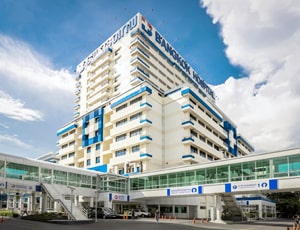
Types of Mastectomy in Bangkok Hospital and its associated cost
| Treatment Option | Approximate Cost Range (USD) | Approximate Cost Range (THB) |
|---|---|---|
| Mastectomy (Overall) | 6769 - 16710 | 241614 - 590794 |
| Total Mastectomy | 6872 - 8830 | 236862 - 313965 |
| Modified Radical Mastectomy | 7816 - 10162 | 286333 - 359169 |
| Radical Mastectomy | 9198 - 11231 | 315550 - 393273 |
| Double Mastectomy | 10001 - 12650 | 361758 - 444218 |
| Skin-Sparing Mastectomy | 7899 - 9986 | 285996 - 367198 |
| Nipple-Sparing Mastectomy | 9000 - 11200 | 316581 - 402742 |
| Subcutaneous Mastectomy | 6645 - 7793 | 244690 - 281116 |
| Prophylactic Mastectomy | 8827 - 12142 | 321841 - 439341 |
DOCTORS IN 13 SPECIALITIES
FACILITIES & AMENITIES
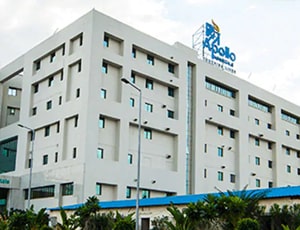
Types of Mastectomy in Apollo Hospital and its associated cost
| Treatment Option | Approximate Cost Range (USD) | Approximate Cost Range (INR) |
|---|---|---|
| Mastectomy (Overall) | 3418 - 8457 | 279091 - 687960 |
| Total Mastectomy | 2814 - 6887 | 231696 - 545907 |
| Modified Radical Mastectomy | 3350 - 7161 | 278417 - 604483 |
| Radical Mastectomy | 3902 - 7916 | 326034 - 644468 |
| Double Mastectomy | 4438 - 8989 | 372831 - 735047 |
| Skin-Sparing Mastectomy | 3321 - 6894 | 274639 - 561892 |
| Nipple-Sparing Mastectomy | 3864 - 7465 | 315999 - 596123 |
| Subcutaneous Mastectomy | 2805 - 5630 | 231646 - 471379 |
| Prophylactic Mastectomy | 3904 - 7866 | 327961 - 650958 |
DOCTORS IN 13 SPECIALITIES
FACILITIES & AMENITIES
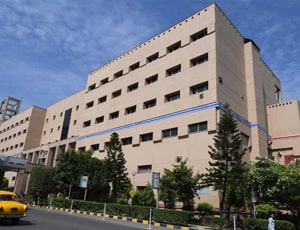
Types of Mastectomy in Apollo Multispecialty Hospitals and its associated cost
| Treatment Option | Approximate Cost Range (USD) | Approximate Cost Range (INR) |
|---|---|---|
| Mastectomy (Overall) | 3370 - 8416 | 282387 - 683408 |
| Total Mastectomy | 2837 - 6742 | 230130 - 544827 |
| Modified Radical Mastectomy | 3445 - 7245 | 271222 - 605365 |
| Radical Mastectomy | 3924 - 8043 | 329450 - 654640 |
| Double Mastectomy | 4513 - 9107 | 364601 - 729578 |
| Skin-Sparing Mastectomy | 3310 - 6647 | 277727 - 545279 |
| Nipple-Sparing Mastectomy | 3924 - 7316 | 317716 - 595646 |
| Subcutaneous Mastectomy | 2862 - 5524 | 226170 - 457310 |
| Prophylactic Mastectomy | 3963 - 7814 | 325489 - 656822 |
DOCTORS IN 13 SPECIALITIES
FACILITIES & AMENITIES
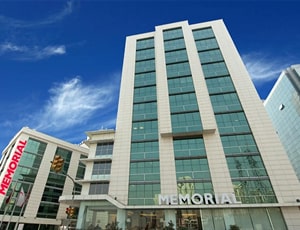
Types of Mastectomy in Memorial Atasehir Hospital and its associated cost
| Treatment Option | Approximate Cost Range (USD) | Approximate Cost Range (TRY) |
|---|---|---|
| Mastectomy (Overall) | 4012 - 9446 | 116722 - 286630 |
| Total Mastectomy | 3367 - 7911 | 101680 - 239794 |
| Modified Radical Mastectomy | 3883 - 8268 | 116967 - 256476 |
| Radical Mastectomy | 4442 - 9174 | 136530 - 271072 |
| Double Mastectomy | 5111 - 10274 | 154387 - 301398 |
| Skin-Sparing Mastectomy | 3942 - 7825 | 118800 - 237301 |
| Nipple-Sparing Mastectomy | 4252 - 8273 | 126939 - 248869 |
| Subcutaneous Mastectomy | 3311 - 6890 | 99620 - 203413 |
| Prophylactic Mastectomy | 4307 - 9048 | 128291 - 274395 |
DOCTORS IN 13 SPECIALITIES
FACILITIES & AMENITIES
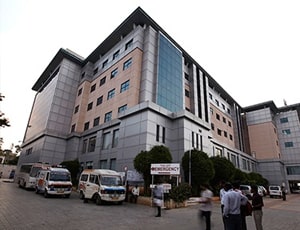
Types of Mastectomy in BGS Gleneagles Global Hospitals and its associated cost
| Treatment Option | Approximate Cost Range (USD) | Approximate Cost Range (INR) |
|---|---|---|
| Mastectomy (Overall) | 3408 - 8522 | 274130 - 687566 |
| Total Mastectomy | 2796 - 6892 | 233033 - 561699 |
| Modified Radical Mastectomy | 3417 - 7316 | 272753 - 587504 |
| Radical Mastectomy | 3963 - 7949 | 316031 - 642983 |
| Double Mastectomy | 4543 - 9124 | 367512 - 743327 |
| Skin-Sparing Mastectomy | 3380 - 6714 | 282253 - 558309 |
| Nipple-Sparing Mastectomy | 4013 - 7351 | 320690 - 587296 |
| Subcutaneous Mastectomy | 2763 - 5626 | 229583 - 453650 |
| Prophylactic Mastectomy | 3917 - 7715 | 319482 - 638502 |
DOCTORS IN 14 SPECIALITIES
FACILITIES & AMENITIES
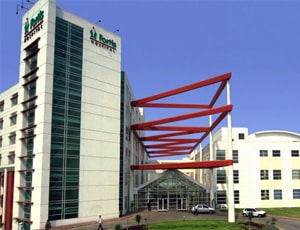
Types of Mastectomy in Fortis Hospital and its associated cost
| Treatment Option | Approximate Cost Range (USD) | Approximate Cost Range (INR) |
|---|---|---|
| Mastectomy (Overall) | 3051 - 7605 | 248630 - 626726 |
| Total Mastectomy | 2536 - 6063 | 208227 - 500786 |
| Modified Radical Mastectomy | 3059 - 6612 | 249700 - 542185 |
| Radical Mastectomy | 3552 - 7135 | 292105 - 581508 |
| Double Mastectomy | 4064 - 8158 | 333444 - 665012 |
| Skin-Sparing Mastectomy | 3053 - 6088 | 249656 - 497104 |
| Nipple-Sparing Mastectomy | 3540 - 6573 | 292682 - 540937 |
| Subcutaneous Mastectomy | 2534 - 5074 | 207980 - 416235 |
| Prophylactic Mastectomy | 3546 - 7093 | 290301 - 584173 |
DOCTORS IN 12 SPECIALITIES
FACILITIES & AMENITIES
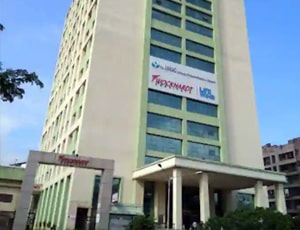
Types of Mastectomy in Wockhardt Hospital, Umrao and its associated cost
| Treatment Option | Approximate Cost Range (USD) | Approximate Cost Range (INR) |
|---|---|---|
| Mastectomy (Overall) | 3054 - 7626 | 250453 - 622737 |
| Total Mastectomy | 2548 - 6102 | 207418 - 500870 |
| Modified Radical Mastectomy | 3047 - 6583 | 249246 - 541324 |
| Radical Mastectomy | 3565 - 7119 | 290237 - 584405 |
| Double Mastectomy | 4068 - 8096 | 332798 - 662911 |
| Skin-Sparing Mastectomy | 3030 - 6092 | 248690 - 500744 |
| Nipple-Sparing Mastectomy | 3544 - 6567 | 291663 - 539974 |
| Subcutaneous Mastectomy | 2525 - 5076 | 208707 - 415973 |
| Prophylactic Mastectomy | 3549 - 7128 | 290498 - 580481 |
DOCTORS IN 13 SPECIALITIES
FACILITIES & AMENITIES
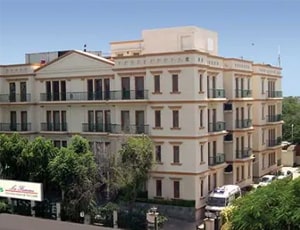
Types of Mastectomy in Fortis La Femme, Greater Kailash II and its associated cost
| Treatment Option | Approximate Cost Range (USD) | Approximate Cost Range (INR) |
|---|---|---|
| Mastectomy (Overall) | 3056 - 7587 | 249677 - 622815 |
| Total Mastectomy | 2536 - 6093 | 208305 - 498659 |
| Modified Radical Mastectomy | 3046 - 6600 | 249799 - 541909 |
| Radical Mastectomy | 3539 - 7107 | 290542 - 585160 |
| Double Mastectomy | 4057 - 8127 | 332665 - 663236 |
| Skin-Sparing Mastectomy | 3037 - 6077 | 250635 - 497304 |
| Nipple-Sparing Mastectomy | 3554 - 6597 | 290674 - 540096 |
| Subcutaneous Mastectomy | 2543 - 5068 | 207972 - 416229 |
| Prophylactic Mastectomy | 3539 - 7115 | 290899 - 581892 |
DOCTORS IN 7 SPECIALITIES
FACILITIES & AMENITIES
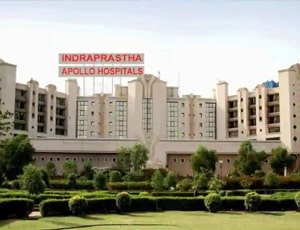
Types of Mastectomy in Indraprastha Apollo Hospital and its associated cost
| Treatment Option | Approximate Cost Range (USD) | Approximate Cost Range (INR) |
|---|---|---|
| Mastectomy (Overall) | 3443 - 8277 | 275378 - 705427 |
| Total Mastectomy | 2795 - 6630 | 228939 - 545248 |
| Modified Radical Mastectomy | 3398 - 7460 | 272127 - 612830 |
| Radical Mastectomy | 3953 - 7821 | 321772 - 637379 |
| Double Mastectomy | 4539 - 8864 | 368571 - 741213 |
| Skin-Sparing Mastectomy | 3376 - 6647 | 272774 - 541288 |
| Nipple-Sparing Mastectomy | 3952 - 7204 | 328140 - 605322 |
| Subcutaneous Mastectomy | 2858 - 5529 | 232876 - 458594 |
| Prophylactic Mastectomy | 3965 - 7840 | 323905 - 638570 |
DOCTORS IN 14 SPECIALITIES
FACILITIES & AMENITIES
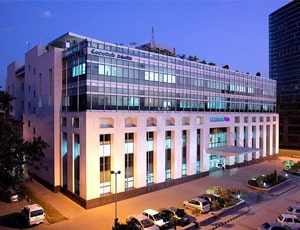
Types of Mastectomy in Manipal Hospital, Yeshwantpur and its associated cost
| Treatment Option | Approximate Cost Range (USD) | Approximate Cost Range (INR) |
|---|---|---|
| Mastectomy (Overall) | 3425 - 8491 | 273379 - 678687 |
| Total Mastectomy | 2872 - 6760 | 228078 - 544541 |
| Modified Radical Mastectomy | 3363 - 7156 | 279568 - 604980 |
| Radical Mastectomy | 3968 - 7920 | 325731 - 636744 |
| Double Mastectomy | 4552 - 9054 | 370736 - 739841 |
| Skin-Sparing Mastectomy | 3396 - 6686 | 279650 - 544461 |
| Nipple-Sparing Mastectomy | 3965 - 7457 | 320263 - 591831 |
| Subcutaneous Mastectomy | 2777 - 5566 | 230988 - 464978 |
| Prophylactic Mastectomy | 3961 - 8010 | 327184 - 635264 |
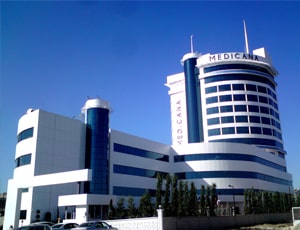
Types of Mastectomy in Medicana Konya Hospital and its associated cost
| Treatment Option | Approximate Cost Range (USD) | Approximate Cost Range (TRY) |
|---|---|---|
| Mastectomy (Overall) | 3875 - 9585 | 120021 - 286170 |
| Total Mastectomy | 3318 - 7739 | 102895 - 236846 |
| Modified Radical Mastectomy | 4007 - 8526 | 119045 - 258872 |
| Radical Mastectomy | 4446 - 8987 | 135240 - 270291 |
| Double Mastectomy | 4994 - 9951 | 151673 - 311796 |
| Skin-Sparing Mastectomy | 3895 - 7729 | 120391 - 235968 |
| Nipple-Sparing Mastectomy | 4209 - 8356 | 126223 - 255552 |
| Subcutaneous Mastectomy | 3403 - 6657 | 103957 - 206645 |
| Prophylactic Mastectomy | 4322 - 9191 | 127904 - 271862 |
DOCTORS IN 9 SPECIALITIES
FACILITIES & AMENITIES
Mastectomy refers to the partial or complete surgical removal of one or both the breasts. This surgery is most often indicated for breast cancer.
A lump in the breast or armpits is one of the earliest signs of breast cancer. It can cause a change in the shape, size, or color of the breast or nipple. Nipple tenderness, inward folding of the nipple, discharge from the nipple, and orange peel appearance of the skin of the breast are the other signs of breast cancer. Patients who observe any of the above-mentioned signs must see their physician immediately.
Your physician may recommend you to undergo a partial or full mastectomy in the following conditions:
Additionally, if you have a family history of breast cancer or deleterious mutation of BRCA 1 and BRCA 2 genes, you are advised preventive mastectomy.
Three types of mastectomy surgeries can be performed in the patients, depending on the extent of the tumor as determined by the CT scan and mammography reports.
This type of mastectomy is carried out when the tumor is small and the surrounding lymph nodes are not infiltrated by the tumor cells. When mastectomy is conducted on both the breast, it is known as double mastectomy. This is also used in cases of invasive ductal carcinoma.
Step 1: Surgical incision at the site of tumor in the breast or breasts or invasive ductal carcinoma (in the case of double mastectomy)
Step 2: Retraction of the intervening tissue
Step 3: Resection of a tumor along with some normal tissue
Step 4: Establishment of drainage
Step 5: Surgical closure of the wound
This procedure is performed when the tumor is large and involves a few lymph nodes.
Step 1: Surgical incision across the nipple
Step 2: Retraction of the intervening tissue
Step 3: Resection of the tumor along with some normal tissue
Step 4: Resection of lymph nodes into which the tumor cells drain (sentinel biopsy)
Step 5: Establishment of drainage
Step 6: Surgical closure of the wound
This procedure is carried out when the tumor is extensive and involves all the lymph nodes and muscles of the breast.
Step 1: Surgical incision across the breast
Step 2: Retraction of the breast tissue
Step 3: Resection of a tumor, muscle and connective tissue of the breast
Step 4: Resection of all the lymph nodes of that side of the body
Step 5: Establishment of drainage
Step 6: Surgical closure of the wound
Apart from the above three procedures, there is lumpectomy (removal of just the lump along with some of the surrounding tissue) and subcutaneous mastectomy (nipple and skin tissue are not removed).
As the anesthetic effect starts to wear off, you may start experiencing pain. Analgesics are administered through an intravenous line for the first two days after the anesthetic effect wears-off. In the case of a simple breast cancer mastectomy, the drainage tubes are removed in the immediate post-operative period. They are retained for two days if you undergo a radical mastectomy. Any signs of inflammation or redness should be immediately reported, as it may indicate infection.
Initially, clear fluid diet is given during the recovery period and then this is slowly progressed to solid food. You should take sponge baths until the incision heals to prevent the occurrence of an infection. You may keep the arms elevated to prevent the accumulation of fluid in the breast cavity. The hospital stay for radical mastectomy is one to two days. The complete recovery may take up to six weeks.
Ask your healthcare adviser for the best multiple options and choose the one that meets your expectations
The average cost of Mastectomy in Thailand starts from USD 15000 Mastectomy in Thailand is conducted across several Healthcare Accreditation Institute, JCI certified hospitals.
Mastectomy package cost in Thailand has different inclusions and exclusions. The cost quoted by some of the best hospitals for Mastectomy in Thailand generally covers the pre-surgery investigations of the patient. Typically, the package cost of Mastectomy in Thailand includes the expenses related to the surgeon's fee, anesthesia, hospital, meals, nursing and ICU stay. Stay outside the package duration, post-operative complications and diagnosis of a new condition may further increase the Mastectomy cost in Thailand.
Many hospitals in Thailand perform Mastectomy. Some of the best hospitals for Mastectomy in Thailand include the following:
While the speed of recovery may vary from patient to patient, they are still required to stay for about 21 days after discharge. This time frame is important to ensure that the surgery was successful and the patient is fit to fly back.
There are certain expenses additional to the Mastectomy cost that the patient may have to pay for. These are the chanrges for daily meals and hotel stay outside the hospital. The per day cost in this case may start from USD 50 per person.
Some of the cpopular cities in Thailand that offer Mastectomy include the following:
There are several doctors who are available for telemedicine consultation for patients requiring Mastectomy in Thailand. The following are some of the best doctors for Mastectomy in Thailand who are available for video consultation:
| Doctor | Cost | Schedule Your Appointment |
|---|---|---|
| Dr. Saipin Tangkaratt | USD 130 | Schedule Now |
| Dr. Suchart Chaimuangraj | USD 81 | Schedule Now |
| Dr. Voratape Kijtavee | USD 81 | Schedule Now |
The patient is supposed to stay at the hospital for about 3 days after Mastectomy for monitoring and care. The patient is subjected to several biochemistry and radiological scans to see that everything is okay and the recovery is on track. After making sure that patient is clinically stable, discharge is planned.
There are more than 4 hospitals that offer Mastectomy in Thailand. These clinics have propoer infrastructure as well as offer good quality of services when it comes to Mastectomy Such hospitals follow all legal protocols and guidelines as specified by the local medical affairs body when it comes to the treatment of international patients.
Some of the best doctors for Mastectomy in Thailand are: